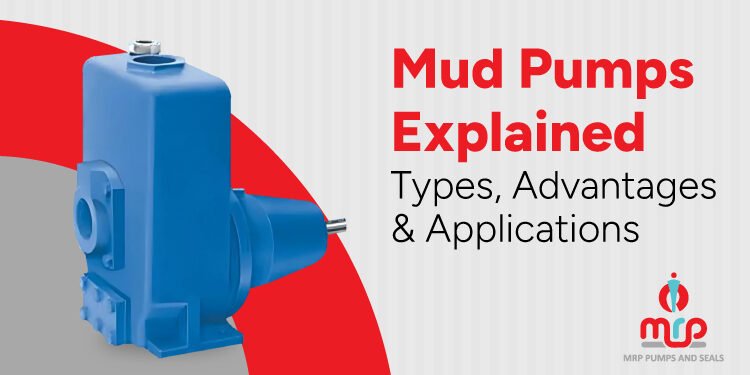Introduction
Industrial operations across oil drilling, construction, and wastewater treatment face a critical challenge: moving high-viscosity fluids, drilling mud, and abrasive slurries efficiently under extreme pressure conditions. Traditional pumps simply can’t handle these demanding applications.
The global mud pump market is projected to reach $1.4 billion by 2032, growing at 4.8% CAGR, driven by increasing oil exploration, infrastructure development, and environmental cleanup projects. This growth reflects the critical role these pumps play in modern industry.
MRP Pumps, a leading manufacturer in Ahmedabad with over 15 years of expertise, has been serving the chemical, oil & gas, paper, and fertilizer industries with reliable pumping solutions. Our sewage mud pumps, and high-pressure systems have become trusted solutions for demanding industrial applications.
What is a Mud Pump?
A mud pump is a powerful industrial pump used to circulate a thick fluid called drilling mud through a wellbore during drilling operations.
This drilling mud plays a crucial role — it helps cool and lubricate the drill bit, carry rock cuttings to the surface, and maintain pressure inside the well to prevent dangerous blowouts.
Mud pumps are built to handle high-pressure and demanding conditions. They use mechanisms like pistons, plungers, or diaphragms to generate the pressure needed to keep the mud flowing smoothly and effectively throughout the drilling process.
How Do Mud Pumps Work
Mud pumps use a reciprocating piston mechanism to convert rotational motion from an electric or diesel motor into powerful linear motion. This action creates the high-pressure force needed to move drilling mud through a wellbore.
The pump operates in two phases:
- Suction Phase: The piston retracts, drawing fluid into the cylinder.
- Discharge Phase: The piston pushes forward, forcing the fluid out under high pressure — often exceeding 5,000 psi.
Major Components
1. Power End:
- Crankshaft & Drive System – Convert motor energy to linear motion
- Crosshead Mechanism – Guides pistons under extreme loads
- Motor – Electric for onshore use, diesel for remote sites
2. Fluid End:
- Pistons/Plungers – Drive fluid movement
- Valves – Control suction and discharge
- Cylinder Liners – Provide durability and wear resistance
- Pressure Chambers – Handle high-pressure demands
3. Performance Specs
- Flow Rate: Up to hundreds of gallons per minute
- Pressure: Up to 7,500 psi
- Power Range: From 50 HP to 3,000+ HP, depending on application
What are the types of Mud Pumps?
1. Classification by Piston Configuration
1. Duplex Mud Pumps
Duplex mud pumps use two pistons to move drilling fluid. They’re simple in design, affordable, and easy to maintain. Ideal for low to moderate-pressure applications.
These pumps are commonly used in small-scale drilling and shallow wells. While less efficient than advanced models, they’re reliable for basic operations.
2. Triplex Mud Pumps
Triplex pumps have three pistons, offering smoother flow with less vibration. They’re compact, powerful, and require less maintenance than duplex models.
Perfect for deep drilling and high-pressure jobs, these are the most widely used mud pumps in oil, gas, and geothermal industries.
3. Quintuplex Mud Pumps
Quintuplex pumps feature five pistons for ultra-smooth operation. They minimize pulsation and improve overall performance.
Used in premium or precision drilling projects, they offer high efficiency but come at a higher cost due to their complex design.
2. Classification by Drive System
1. Electric Mud Pumps
Electric mud pumps run on electricity, making them quiet, energy-efficient, and emission-free. They’re ideal for eco-sensitive zones.
Best suited for onshore and urban operations where power supply is stable and sustainability is a priority.
2. Diesel Mud Pumps
Diesel-powered pumps are rugged and independent of external power sources. They’re built for high power and remote use.
Commonly used in offshore or remote drilling sites where electricity isn’t available or reliable.
3. Specialty Mud Pump Types
1. Diaphragm Mud Pumps
Diaphragm pumps use a flexible membrane to move fluids. This isolates the fluid from moving parts, reducing wear.
Great for handling corrosive, abrasive, or chemical-laden fluids, especially in mining or chemical industries.
2. Peristaltic Mud Pumps
These pumps move fluid through a tube using rollers, ensuring gentle, contamination-free flow.
Ideal for sensitive or sterile fluid handling in labs, construction, or light industrial applications.
3. Hydraulic Mud Pumps
Hydraulic pumps use pressurized fluid to drive pistons, offering smooth and consistent operation.
Best for precision drilling where low vibration and pressure stability are essential.
What are the Major Advantages of Mud Pumps?
1. Operational Efficiency Benefits
1. Improved Drilling Efficiency
Mud pumps keep the drilling process smooth by circulating fluid continuously, which helps remove cuttings quickly. This boosts drilling speed and can cut down project time by 20–30%, saving both time and money.
2. Precise Pressure Control
They help maintain the right pressure and flow, ensuring that the drill stays on course. With real-time pressure monitoring, chances of errors or wellbore issues are greatly reduced.
3. Better Cooling and Lubrication
Mud pumps cool the drill bit and reduce wear on machinery. This leads to longer tool life, less downtime, and fewer equipment replacements, making operations smoother and more cost-effective.
2. Safety & Environmental Benefits
1. Blowout Prevention
By maintaining proper pressure in the well, mud pumps prevent dangerous blowouts—a critical safety feature in oil and gas drilling.
2. Environmentally Safer Operations
Mud pumps ensure that fluids stay within the system, which reduces environmental risks and helps meet safety and environmental regulations.
3. Economic & Long-Term Benefits
1. Lower Operating Costs
Modern mud pumps are energy-efficient and require less maintenance, which reduces overall running costs by up to 25% compared to older systems.
2. Durability & Reliability
Built with strong materials and smart engineering; high-quality mud pumps can run reliably for over 10–15 years when maintained well. This means fewer breakdowns and better return on investment.
Applications of Mud Pumps Across Industries
1. Oil & Gas
Mud pumps are important in oil and gas drilling—both onshore and offshore. They circulate drilling fluid to cool the drill bit, remove cuttings, and maintain well pressure. High-pressure mud pumps are essential for deepwater drilling and shale gas extraction.
2. Chemical & Pharmaceutical
In these industries, mud pumps handle aggressive, corrosive, or viscous fluids during chemical transfers, mixing processes, and waste treatment. Their sealed systems ensure safe, contamination-free operation.
3. Paper & Pulp
Used for pulp transfer, coating processes, and wastewater handling, mud pumps support efficient fluid movement in manufacturing lines where slurry-like materials are common.
4. Building & Construction
From foundation drilling and soil stabilization to dewatering and tunnelling, mud pumps support high-pressure fluid movement for smooth and safe operations on construction sites.
5. Water & Wastewater Treatment
Mud pumps are essential for sewage handling, stormwater management, and industrial effluent treatment. Their ability to handle sludge, grit, and corrosive materials makes them ideal for municipal and industrial water systems.
6. Thermal Power Plants
Used for ash slurry disposal, water circulation, and chemical dosing. Mud pumps withstand high temperatures and abrasive materials in demanding power plant environments.
Comparison Table: Mud Pump Types
| Pump Type | Pressure Rating | Initial Cost | Maintenance | Best Applications | Efficiency |
| Duplex | Up to 3,000 psi | Low | Simple | Small drilling, light industrial | Good |
| Triplex | Up to 7,500 psi | Medium | Moderate | Most drilling, heavy industrial | Excellent |
| Quintuplex | Up to 10,000 psi | High | Complex | Premium drilling, precision apps | Superior |
| Electric Drive | Varies | Medium | Low | Urban, indoor applications | High |
| Diesel Drive | Varies | Medium | Higher | Remote, mobile applications | Good |
How to Select the Right Mud Pump for Your Application?
1. Understand Your Application Needs
- Identify the type of fluid (mud, slurry, wastewater, etc.)
- Check viscosity, abrasiveness, and corrosiveness
- Define your environment: onshore, offshore, high temperature, remote location, etc.
2. Determine Pressure & Flow Requirements
- Calculate required flow rate (GPM or LPM) based on application
- Determine maximum pressure needed (PSI or Bar)
- Add a 10–20% buffer above peak values for safety and reliability
3. Choose the Right Pump Type
- Duplex, Triplex, or Quintuplex based on flow and pressure needs
- Electric vs Diesel depending on power availability and operational environment
- Specialty pumps like diaphragm or peristaltic for unique fluids
4. Match Material to Fluid Compatibility
- Use stainless steel, alloy, or lined materials for corrosive fluids
- Ensure wear-resistant components for abrasive slurries or chemicals
5. Evaluate Power Requirements
- Calculate horsepower (HP) or kilowatt (kW) needs
- Consider energy efficiency for long-term savings
6. Analyze Total Cost of Ownership
- Balance between initial investment and long-term operating/maintenance costs
- Consider spare parts availability, service support, and durability
7. Consult Industry Experts
- Work with experienced manufacturers to ensure your pump fits your exact operational needs
- Look for customization options to optimize performance
→ Need expert help choosing the right mud pump? Contact MRP Pumps Today!
Mud Pump Maintenance: Best Practices for Long-Term Performance
Proper maintenance is critical to keeping mud pumps operating efficiently, especially in demanding environments like drilling, mining, and wastewater treatment. Proactive care not only extends the pump’s life but also helps prevent unexpected failures that can halt operations and increase costs.
1. Regular Preventive Maintenance
- Check Key Components: Regularly inspect seals, valves, pistons, liners, and bearings for wear or damage.
- Timely Replacement: Replace worn-out parts before failure to avoid unplanned downtime or system damage.
- Lubrication: Ensure moving parts are well-lubricated according to manufacturer specifications.
2. Prevent Common Mud Pump Issues
- Cavitation: Caused by poor suction conditions — ensure correct suction line sizing and maintain adequate Net Positive Suction Head (NPSH).
- Seal Failures: Frequently inspect and replace worn seals and gaskets to prevent leakage and pressure loss.
- Excessive Vibration: Keep the pump properly aligned and securely mounted to reduce vibration, which can damage internal components over time.
3. Optimize Pump Efficiency
- Monitor Performance Metrics: Track flow rate, pressure levels, and energy consumption to detect inefficiencies.
- Use Smart Monitoring Systems: Integrate sensors or digital tools to alert you of abnormal operation — enabling predictive maintenance.
- Record & Review: Maintain detailed maintenance logs to identify recurring issues and improve planning.
Why Choose MRP Pumps for Your Mud Pump Requirements?
1. Over 15 Years of Experience
We bring decades of trusted expertise in designing and manufacturing mud pumps for various industrial applications.
2. Strategic Location Advantage
Our facility in Kathwada, Ahmedabad offers easy access to industrial infrastructure and nationwide delivery support.
3. Wide Range of Application-Specific Pumps
From sewage mud pumps for wastewater treatment to triplex high-pressure plunger pumps for drilling operations, we offer solutions tailored to your industry.
4. Superior Build Quality
Every pump is manufactured using premium materials and precise engineering, ensuring reliable performance under tough operating conditions.
5. Cost-Effective Solutions
We offer competitive pricing while maintaining the highest standards of quality and durability.
6. Comprehensive Support Services
Our team provides complete assistance from product selection to installation and ongoing maintenance support.
7. Multi-Industry Expertise
Trusted by leading companies in oil & gas, chemical, paper, construction, and wastewater industries.
8. Focused on Innovation
Continuous investment in R&D helps us stay updated with the latest technologies and evolving customer needs.
Conclusion
Mud pumps represent critical infrastructure for modern industrial operations across oil & gas, construction, mining, and wastewater treatment. Understanding the different types, applications, and selection criteria ensures optimal performance and cost-effectiveness.
The growing market reflects increasing demand for reliable, efficient pumping solutions in challenging environments. Technology trends toward automation, electric drives, and smart monitoring systems will shape future developments.
MRP Pumps stands ready to support your mud pump requirements with 15+ years of expertise, quality manufacturing, and comprehensive support services. Our commitment to customer success and technical excellence makes us the preferred partner for demanding industrial applications.
Whether you need sewage mud pumps for wastewater treatment, high-pressure systems for drilling operations, or custom solutions for unique applications, MRP Pumps delivers reliable performance backed by extensive industry experience.
Contact MRP Pumps today at mrppumps@gmail.com or +91 98259 69278 to discuss your specific requirements
Frequently Asked Questions
Mud pumps are specifically designed for high-viscosity fluids, abrasive materials, and high-pressure applications up to 7,500 psi. Regular water pumps handle clean fluids at lower pressures and lack the robust construction needed for industrial mud and slurry applications.
Quality mud pumps typically last 10-15 years with proper maintenance, though this varies by application severity and maintenance practices. High-pressure drilling applications may require more frequent component replacement compared to lower-pressure industrial uses.
Duplex pumps use two pistons and cost less initially but provide lower efficiency and more pulsation. Triplex pumps use three pistons, offering smoother flow, higher efficiency, and better pressure control, making them the industry standard for most applications.
Yes, mud pumps are specifically designed to handle solids, abrasive slurries, and high-viscosity fluids. Specialized designs like MRP Pumps’ slurry pumps use wear-resistant materials and robust construction to handle the most demanding abrasive applications.
Regular maintenance includes checking seals, valves, and wear components, monitoring pressure and flow rates, and replacing worn parts according to manufacturer schedules. Proper maintenance prevents costly failures and ensures optimal performance throughout the pump’s service life.





